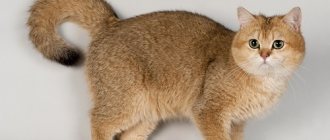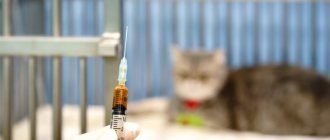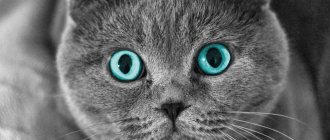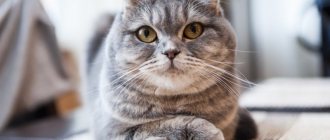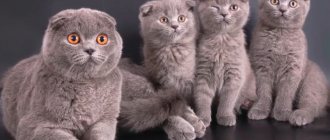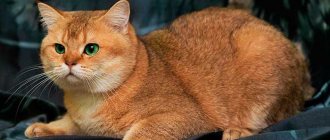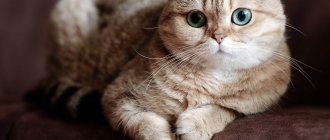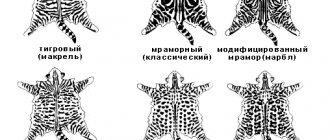Description of black smoke cats
Scottish cats and black smoke cats seem not as black as their solid counterparts due to the light undercoat: the hair is not dark along the entire length, but is colored plus or minus half. The color does not seem uniform, but as if it has inclusions or tints.
The Scottish Fold or straight-eared smoky kitten has a color that can shimmer when moving, changing slightly depending on the lighting. Because of this, many inexperienced owners cannot determine what color their animal is - either solid (if the smoke is very uniform), or tabby (if the color is uneven, looks like a patterned one). In fact, these are Scottish smoke-colored kittens.
With age, the smoky color, similar to a tabby, can become full-fledged smoke, or it can remain so patterned. In the second case, we are dealing with an insufficiently good smoky color. Poorly colored smoky shorthaired cats are sometimes confused with tabbies because... it seems like they are striped. However, many people really like this coloring, so if you are not going to take the animal to shows, it is quite possible to buy such a kitten to enjoy its appearance.
In this photo, an adult smoky cat has a residual pattern.
You can distinguish black smoke, no matter how good or bad it is, from others by looking at the mirror of your nose. The smoky cat has a black nose without a line, unlike the tabby cat. And in order to distinguish smoke from black solid (solid color), you need to move apart the undercoat and look at the presence of two different colors in the smoke or at solid color in solid.
As an adult, around the age of two, the Scottish Smoky cat has a fully formed color. The lighter the lower part of the hair, the more valuable the cat is. It is desirable that the contrast of colors be uniform throughout the body. Long-haired cats, that is, Highland Straights and Highland Folds, look more advantageous with this coloring - the shimmer is more noticeable on them. Almost like this Persian cat.
In the international classification, the smoky color is designated by the letter s (from the English “smoke”, which means “smoke”).
There are usually few smoky cats at shows, because... The quality of their color is influenced not only by genetics, but also by many circumstances: they are rarely in ideal shape. At the same time, judges are very picky about the shortcomings of this color, so it is difficult to get a title.
Description of color
The black (smoke-like) Scottish cat is one of the most common options. Its color is usually uniform, without any inclusions. If it is necessary for your pet to participate in exhibitions, then the color cannot have any spots of a different color or a red tint (rust). For this reason, the jury may lower scores or simply not allow it.
Only babies can have a slightly uneven color or a light undercoat, since this shade takes quite a long time to form. When the color has already formed, the animal looks very impressive.
And the smooth-haired representatives also have black pads and a nose.
Genetics of black smoke color
To get black smoke, a cat must have not only the gene for black coat color B and pigment density D, but also the smoky color inhibitor gene, which blocks the synthesis of pigment in the cells of the hair follicles. As a result of its action, only the upper part of the guard hair is painted, and the root part remains devoid of pigment. As soon as the hair stops growing, i.e. reaches its maximum, the inhibitor gene I (from the word “inibitor”) stops acting on this hair.
However, the inhibitor gene in combination with the gene for density and black pigment is not enough for the animal to be smoky. Such individuals also have non-agouti (aa) genes, that is, genes for non-patterned (non-tabby) colors. The combination of aaII (or aaIi) genes produces haze.
Caring for smoke-colored cats
Smoky cats are very demanding in care, because... In unkempt animals, the fur becomes discolored, fades, and “rusts.” Care means not only regular brushing and combing of the coat, but also a balanced diet, and also protection from frequent, prolonged exposure to sunlight.
It is recommended to wash black show cats with professional shampoos that enhance the black color. And, oddly enough, it is better to wash black smoky cats with whitening shampoos for white cats. The enzymes contained in such shampoos perfectly whiten the root zone, and make the ends of the hair appear shiny.
In addition to shampoo, when grooming, you can use a balm to volume the coat. Then the hairs will be raised and show off the haze more favorably.
You also need to carefully monitor traces of tears, which dry up and become crusts, and after they are removed, if you clean the area around the eyes irregularly, yellowish spots may remain. It will take a long time to get them out. Therefore, it is better to regularly use cleansing eye lotions for preventative purposes as tear stains appear.
Long-haired smoke-colored Scots need to be brushed frequently to prevent mats from forming. If in cats of a different color the tangles can simply be cut out, then in smoky cats such manipulation will lead to dark guard hairs growing in place of the light undercoat - a dark spot will appear on the body.
Furminators are also not suitable for combing such cats. The fact is that the furminator can damage the undercoat - the result can be as disastrous as in the case of cutting out the mat. Also, such cats should never be trimmed. It is better to bathe thoroughly during molting and comb it either with a regular comb with fairly sparse teeth, or with a special silicone paw.
And, of course, one should not allow heavy or prolonged shedding in smoky animals, so that they do not lose their undercoat, which forms all the beauty, and also so that the coat does not fade. In order for molting to be less intense, a balanced diet and vitamin intake in courses are necessary if the cat is on a natural diet or on non-vitaminized factory feed.
Features of care
Coat
Bearers of this color are quite fastidious in their care. Stress, unbalanced nutrition, dry air, liver disease, etc. lead to dullness, the appearance of spots, a reddish tint in color, and the formation of dandruff. Smokes have a thin, delicate undercoat. Some owners put it “like a cobweb.” It is important for them to carefully comb their fur and use special shampoos and conditioners. Moreover, hygiene products for black cats are not suitable for coal smoke, since they give a tinting effect, and for tipping the main thing is contrast. It is recommended to use AII SISTEM, Bio-Groom, WHITENING products, not forgetting an individual approach.
The wool does not tolerate open sun, it turns brown from ultraviolet radiation, and spots may appear.
Feeding and assistance
Such fluffies should not be fed algae.
Regarding nutrition, the following recommendations are made:
- It is necessary to ensure sufficient dosage of vitamins A, E, D.
- Avoid seaweed, liver, and foods containing yeast.
- Limit prepared foods, as they often lead to contrast blurring.
If problems arise while caring for an animal, you need to seek help from a groomer. This is a specialist who will tidy up not only the fur, but also provide high-quality care for the pet’s eyes, ears, teeth, paws and claws so that it has a healthy and unsurpassed appearance, and while observing the animal, he will give individual recommendations on care and nutrition.
Scottish kittens smoke color
The smoky color is formed by a combination of the dominant allele I of the melanin inhibitor gene and recessive alleles of the Agouti gene (aa). The smoky color inhibitor gene in the cells of the hair follicles blocks the synthesis of the dye. As a result, the upper part of the guard hair, which was formed first, turns out to be dyed, and the younger lower part turns out to be almost white - it is devoid of pigment. The inhibitor gene stops its action when hair growth stops and resumes its work during the development of new ones. It does not have time to get involved in the process of formation of pigment in the short hairs of the undercoat, so the undercoat of the “smoke” is not colored. The quality of the color also depends on the inhibitor gene: if it works actively and turns on simultaneously in all pigment cells, the smoky color will look great.
Unusual colors of Scottish cats: features of colors for different types of breed
Content
The uniqueness and variety of colors of Scottish cats is truly amazing. Single-color, bicolor, tortoiseshell, shaded, van, harlequin, tabby, smoky - all these are possible shades of the coat of a purebred pet. In order not to have any doubts about the purebred of the Scotsman, you need to know what shades of coat this breed has.
Origin story
The ancestors and closest relatives of the Scottish Fold are considered to be British Shorthair cats, so the Scots have existed as a separate breed for only about 50 years. In 1961, Englishman William Ross acquired an unusual fold-eared kitten from a farmer he knew. His mother, the white fold-eared cat Susie, was the first representative of this breed to be seen. In 1965, Scottish Folds were registered with the Board of Directors of Cat Breeds, and five years later the breed received its official name.
Plain (solid, solid)
The monochrome uniform coloring of Scottish cats is considered classic by breeders. The solid or solid color of the animal implies the absolute exclusion of any inclusions, small marks and specks of a different color. The tone is rich, even along the entire length of the coat.
The most common used to be considered blue plain Scots. But today among the representatives of the breed there are many other variants of solid colors.
White
A Scottish cat with snow-white fur (without yellowness) looks luxurious. Possible eye colors are blue, amber, copper. According to the standard, eyes of different colors are allowed. The paw pads and nose are light pink.
Kittens may have markings of a different shade, which disappear after the first coat change. By the age of two, the coat of a white Scot should be crystal clear, without spots of a different color.
Black
The black cat has expressive yellow eyes. The nose and paw pads practically blend into the main color of the animal.
On the shiny bright coat of the Scottish beauty Ebony, 2-3 hairs of contrasting white color are allowed. The presence of large red or brown marks is not provided for by the standard.
Important: Scottish Fold pets are endowed with magical abilities. It is believed that it is the black color of the Scottish Fold that protects the house and its inhabitants from evil spirits.
Chocolate
The brown Scottish cat, also called chocolate, looks noble and impressive. The color of the coat contrasts with the animal's yellow, golden or copper eyes. The nose and paw pads are also dark brown.
Lilac (lavender)
The monochromatic lilac Scottish Fold has a gentle gray tint that smoothly turns into cream. The nose is slightly brownish, the paws on the bottom are the same color as the coat, in harmony with the main color of the pet. This lilac-lavender color goes well with eyes of copper, amber or orange shades.
Red (red)
Red or ginger color is a rare and valuable color of the Scots breed. The fiery edge is combined with burning amber irises. Pads and nose to match the dominant color.
The tail of kittens and adult animals is not very evenly colored. This deficiency does not disappear with age and is allowed by the standard. And the presence of marks on the head and limbs that remain after reaching the age of two are considered a deviation from the norm.
A red Scottish straight-eared cat can give birth to kittens not only with erect ears, but also with ears pressed to the head.
Cream
The cream or peach fold cat is infinitely elegant and beautiful. The delicate background of light fur, bright golden eyes and a pinkish nose give the pet an irresistible appearance. The pads on the paws are also pink. An animal with this color is similar to a red Scotsman, but its coat color is a shade lighter.
A peach fold kitten may have a blurry, fuzzy pattern on its paws and tail that does not disappear with age. This is not critical for a purebred pet, but leopard markings are absolutely unacceptable.
Faun (deer)
There is another unique color of Scottish fold cats with an interesting name - fawn, which means “young deer”. The nose and pads on the paws of these beauties are beige-pink.
Description of the breed
Scots, like their closest relatives - British Shorthair cats, have a powerful, squat body with well-developed muscles. The neck and legs are powerful, short, the head is large and round, with a developed chin and pronounced cheeks. A distinctive feature of the breed are small triangular ears, which are pressed tightly to the skull, and their tips are directed forward and slightly downward due to a specific crease in the cartilage. Large and round eyes match the color, but most often have an amber-yellow color. The tail is long, slightly tapering towards the tip.
The Scots, like the British, have a luxurious plush “fur coat” with a thick undercoat. There are a wide variety of color options: plain: black, red, white, blue, cream; combined: silver chinchilla, smoky, marbled, tortoiseshell, tabby and many others.
Photos
Character
The Scots love to play and frolic, involving everyone around them in their games. Hide and seek, chasing, hunting for candy wrappers or rubber balls, walking on their hind legs - these are the favorite pastimes of these good-natured naughty creatures. Many owners note their cats’ love of watching TV while lounging comfortably on the sofa.
These lop-eared beauties tolerate loneliness well, and are unlikely to sulk at you if you come home late from work or stay late at a party. But they won’t be silent either, if they are bored or hungry, they will notify you of their needs in a loud, slightly creaky voice.
Care and maintenance
Although Scots are naturally quite low-maintenance cats, there are a few simple things you should do before bringing a kitten into your home. First, hide all wires, cables, chargers, headphones and fragile items away. Secondly, buy a comfortable tray and teach the kitten to use it from the very first day. Prepare a sleeping place for your cat or purchase a special cat corner - with a sleeping place and a scratching post. To prevent your pet from getting bored, buy him special toys.
Pay special attention to caring for your pet's fur: once a week, the cat should be combed with a special brush (daily during the molting period). It is better to avoid slicker brush so as not to damage the undercoat. It is enough to bathe your Scot once every six months: the main thing is to dry him thoroughly after water treatments and keep him away from drafts. Once every 2-3 weeks, trim the tips of the claws and clean the ears with a cotton swab to remove accumulated wax and dirt. But the eyes need to be checked every day: if the animal continues to have watery eyes or purulent discharge for a long time, be sure to contact a veterinarian.
Two-color
A unique coat color is bicolor (two-color cats). The main background is snow-white. The second color in color (cream, black, blue, red) is presented in the form of unusual patterns. Thoroughbred representatives must have white belly, neck, chest, paws, muzzle and beard.
A prerequisite is the predominance of a white background in color. Bicolors are more valued; their body patterns are symmetrical. The eyes can be any shade, but are usually blue or golden yellow.
Cream bicolor
Cute white cats with additional streaks of delicate cream tones. The eyes are blue or yellow, and the nose and pads are pink.
Blue bicolor
The pattern on the wool is blue (delicate or rich gray). The iris of the eyes is a beautiful sky tone or yellow-orange. The nose and paws below are pink.
Black bicolor
Black and white bicolor is characterized by patterns of rich black tone. These cats have a pink nose and blue or copper eyes. A symmetrical, distinct pattern on the skin turns the cat into a real gentleman in a tailcoat.
Colors of Scottish Fold cats
Coat color is determined by the gene set. The Scottish Fold has two predominant colors: black and red. The genes responsible for the manifestation of a particular color are recessive (weak) and dominant (strong). The color saturation of the coat depends on the combination of these genes.
INTERESTING! In white Scottish cats, the color gene can be either absent or dominant. In the first case, they speak of an albino individual, in the second, of an animal with dominant white fur.
In total, there are 22 coat colors of fold-eared cats:
- blue;
- black;
- red;
- white;
- cream;
- chocolate;
- lavender;
- faun;
- cinnamon;
- bicolor;
- tabby (patterned) – marbled, spotted, brindle;
- smoky;
- shaded;
- chinchilla;
- point - cream, lilac, blue, choclit, tortie, tabby.
Solid
Such colors are also called solid. Even the slightest inclusions of other colors are unacceptable. The wool should be evenly colored, each hair from tip to root should have the same shade. If there are inclusions, then the kitten is considered defective, it is rated poorly at the exhibition, and is sold inexpensively.
Until recently, the most common Scots folds were blue ones. But today Scottish pets come in a variety of solid colors. Although red, black and chocolate representatives of the breed are still rare.
| Color | Peculiarities |
| gray (blue) | may be closer to gray or blue, newborn cubs have stripes on their fur coat, but they disappear after a few months, the irises are amber |
| black (ebony) | purebred is indicated by a dull black color; if it has a reddish tint, then the animal is not purebred, the eyes are amber, the nose and paw pads should also be black |
| white | as in the case of black coloring, pure white color indicates purebredness, it should not have a yellow tint, newborn kittens have black spots, but after a few months they should disappear, the irises of the eyes can be blue, amber, red-brown (heterochromia is possible), earlobe and pads pink |
| brown (chocolate) | rare color, irises yellow or red-brown |
| lilac (lavender) | light gray coat has a bluish-pink tint, eyes are amber, red-brown or dark yellow, nose is light brown |
| light lilac (faun) | visually almost similar to the previous color, although in fact it is a light cinnamon, the lobe and pads are pinkish-beige |
| cinnamon | also called cinnamon color (lighter than chocolate, but paler than red), nose and pads are brown, pink or beige |
| red (red) | the tail has an uneven color, and this feature does not disappear in adult cats, but if an animal older than 2 years has spots on its paws and head, then this does not correspond to the breed standard, the eyes are amber |
| cream (peach) | the color is similar to the previous one, but lighter, in adult cats barely visible spots on the paws and tail are possible, but noticeable spots on the body are unacceptable, yellow eyes, pink earlobes and pads |
In addition to black, red and chocolate, valuable colors of Scottish Fold cats are those in which the coat is shimmering with gold or silver. It is difficult for breeders to maintain such colors, since they are unstable and can be lost when combined with other genes during crossing.
Bicolor
That is, two-color wool. Part of the coat is white, the other part may be:
- blue;
- red;
- creamy;
- tabby
With the latter option, the pattern should have strict symmetry. The more symmetrical the pattern, the more expensive the animal is.
White color is required for bicolor. Scottish Fold cats usually have white faces, chins, necks, chests, bellies and paws. Eyes come in both yellow and blue shades.
Tabby
Dark spots that contrast with a lighter color base are tabby. In Scottish cats, patterns usually cover not only the body, but also the face, ears, neck, paws, and tail. A pattern in the form of the letter “M” is clearly visible on the forehead.
The table shows the color options for tabby Scottish cats.
| marbled color (shaded tabby) | the animal's shoulders are covered with spots in the form of butterfly wings, three wide stripes run along the spine, the tail is decorated with many small spots, silver and golden marble are especially prized |
| spotted (spotted tabby) | there is one wide stripe along the spinal column; on the sides of the body there are spots in the shape of circles and ovals |
| brindle (mackerel tabby) | stripes cover the entire body, this color is also popularly called “whiskas”, because a Scottish cat who starred in a cat food commercial had this type of fur. |
Also, tabby colors in Scottish Fold cats are classified according to the color of the base and spots:
- silver base – black spots;
- silver with blue spots;
- red with dark red;
- brown with black;
- cream with blue;
- cream with dark cream;
- white with red patterns.
Tipping
This term refers to the transverse division of the hair into two tones. Typically, the upper part of the hair of a Scottish Fold cat is dark or black, the lower part is light (white or silver shades).
The tipping color varieties of Scottish cats are listed below.
| variety | peculiarities | subtypes |
| smoky | a special gene gives the gray color a beautiful silvery tint, the breed is also called “black smoke”, but its representatives are considered defective and are not allowed to exhibit | |
| chinchilla | incredibly beautiful wool, you will have to pay more for such a kitten than for a standard “Scottish” | silver, golden and blue chinchillas (the latter is the rarest and most expensive) |
| shaded | These cats have a white undercoat | silver, gold and red |
Color point
This is the name of the “Siamese” coloring: the body is light, and the muzzle, ears, paws and tail are dark or black. A special gene forms the original color. When it is present in areas of the body where blood circulation is weaker, fur pigment is intensively produced.
NOTE! Scottish point cats have blue irises.
Scottish Straight and Scottish Fold cats have the point color:
- cream;
- lilac (purple spots);
- blue (gray-blue);
- choklit (brown);
- cakes (red and cream);
- tabby (striped).
Color point
Color-point is translated from English as “colored point”. The point coloring is explained by the presence of a gene, under the influence of which the coloring of hairs intensifies in some areas of the body with insufficient blood circulation. Characteristic darkening appears on the main white or cream background of the coat.
The second name of the color is Point Links. The eye color of cats of this color is necessarily blue. Previously, this coat color was observed only in the Siamese breed. But today it is present in other cat species, including Scots.
Newborn kittens are completely white. Only by the age of one month do babies begin to show color on their ears, paws, tail and face. According to this color, several subspecies are distinguished among the points.
Blue Point
This color is characterized by a pale gray-blue, almost white shade of the body with darker, gray markings. Soft gray Scottish blue point kittens have paws and noses that match the main color.
Cream point
The body is creamy white, and the shading on the animal’s face and tail are pastel cream colors. Paw pads and nose are pink. This point color goes harmoniously with the expressive blue eyes of the cat.
Lilac Point
The dominant tone is soft white or lilac, and the markings are gray with a pink tint. The nose and paws are the same as the main color.
Seal Point
The darkest color among the points. The dominant tone is beige. Contrasting with it are brown and black markings. The same dark nose button and paw pads.
Chalklit Point
Chocolate or choclit point is distinguished by a brown pattern on a cream background. Paw pads and nose range from light cocoa to darker brown.
Red point
The main coat color is pale apricot, almost white. Darkening on certain parts of the body is red-red in color. The pads and tip of the nose are bright pink.
Color point
Harlequin
Color Point is a rare type of Scottish cat with a color similar to that of Siamese cats. In infancy they looked a little like Thai kittens. The main background is white or cream. The muzzle, ears, paws and tail are painted in darker shades. Color Point or Link's Point has blue eyes.
They owe their color to their British ancestors, whose family included Persians of this shade. By the way, it is very difficult to distinguish a British cat from a Scottish one, and even professionals cannot always do this.
Tortoiseshells (torties)
The tortoiseshell color of Scottish Folds is usually tri-colored. Red, white, and black spots are located on a cream or red dominant background. When the genes of the parents are combined in a tortoiseshell kitten, these markings can take on chocolate, blue and cream shades.
When assessing tortoiseshell cats, felinologists pay attention to the even distribution of markings and the intensity of their tone. Fold-eared and straight-eared Scots with a tortoiseshell color are divided into subspecies (depending on the color scheme of the spots).
Black-red
There are black and red-red patterns all over the cat's body. The sizes and shapes of the spots are very diverse. This color is often called tortie.
Chocolate red
The patterns on the wool are brown and red. They stand out against a lighter background and look very interesting. The chocolate red color is considered rare and prized by breeders.
Blue-cream
The tortoiseshell blue-cream color in Scottish pets is determined when the main gray-blue background is covered here and there with small light cream spots.
Important: tortoiseshell coloring is characteristic only of cats. The calico cat is very rare. The appearance of a male tortoiseshell kitten indicates genetic problems. Most likely, an adult pet will not be able to have offspring, since the reproductive functions of its body are impaired.
Tabby (tabby)
Tabby is one of the most popular cats among Scots. The color of Scottish tabby cats is distinguished by the presence of a pattern in a certain place on the coat. The pattern on the coat can be anything. A characteristic feature is an M-shaped pattern on the forehead.
The color of a tabby cat depending on the type of pattern:
- Striped, like a tiger (has vertical stripes on the sides);
- noticed;
- Marble (pattern of chaotic spots and stripes of different sizes).
And depending on the color combination to the following:
- golden striped;
- cream striped;
- blue;
- black marble;
- marble on silver
- silver-blue (grayish tint)
- silver (silver tint);
- cameo.
Smoky (smoky, tuxedo)
The color of Scottish Fold cats can be smoky. On top the coat is one color, for example black. And at the base, each hair is silvery-white. This coloring is characteristic of cats with a dominant silver gene, which creates unusual combinations of light and dark shades.
Smoky color is easy to confuse with solid color. To avoid mistakes, you just need to look at the undercoat. With a smoky color, the undercoat of a different shade is clearly visible, and with a solid color, the color of the roots does not differ from the tips.
The eyes of smoke cats are usually yellow-gold in color. Based on the shades of smoke on the fur, several subspecies of this color of animal are distinguished.
Blue smoke
Smoky blue Scottish Straights and Scottish Folds are distinguished by the color of their fur coat with a gray cold coating. But underneath the fur is white and silvery. The paw pads and nose of these pets are gray-blue.
Black smoke
This color in Scottish cats is characterized by a black edge, but the hair at the roots is white. The nose mirror and pads do not differ from the main background.
Chocolate smoke
The snow-white undercoat is combined with a brown-chocolate topcoat. The nose button and paw pads of these animals are brown in color.
Smoky Scottish Straights and Scottish Folds, despite their unique color, cannot participate in exhibitions. Such cats are not recognized by the breed standard.
Characteristic
Such a fluffy will definitely get along with the people around him.
Black cats are considered the most obedient, kind and responsive, especially when compared with the characters of individuals of other colors. But this is only true for males. Smoky “emers” are often credited with being unobtrusive, but not shy either. They get along well with people and animals. Each breed has its own personality traits. For example, the Scottish representative knows how to make a show by begging for delicacies. The cat stands on its hind legs and, moving its front legs, looks intently into the eyes.
Chinchilla
The Scottish chinchilla borrowed the extravagant colors of its coat from the British, and they, in turn, from Persian cats. A chinchilla kitten is born only from parents with an unusual color. Each hair is colored in two colors.
Most of it is light in color and 1/8 of it (the top) is dark in color. This phenomenon is called tipping.
Tipped chinchilla colors can be of 3 types:
- Golden. The cat has a white undercoat. But on top there is a reddish coating over almost the entire surface of the body (on the sides, back and tail of the animal). Only the beard, the tips of the ears and the belly are white. Yellow-gold eyes, pink pads and a brick-colored nose.
- Silver. White wool coated with silver gives an interesting gray effect. The color of the tail has a hint of stripes, the nose is beige, and the eyes are green. Snow-white tips of the pet's ears, chin and belly.
- Blue golden. The rarest and therefore valuable color of Scottish chinchillas. The undercoat is a delicate caramel color, and the tips of the hair are a radiant blue hue. The eyes are natural emeralds of a rich green tone.
Shaded (shedded) colors
An unusual definition refers to the interesting color of Scottish cats - shaded colors. These pets have almost white fur, but the tip of the guard hair is colored.
The top layer of a cat's coat can be any shade typical of Scottish cats. The undercoat is white. The sides, back, head, tail and ears are shaded. Light belly, chin and lower tail. There should be no obvious spots. The “M” sign on the forehead and darkish rings on the paws are acceptable.
Shedded colors can be of three varieties:
- Golden. The fur of the Scottish cat is golden, the undercoat is cream or light peach. Green eyes are very expressive and beautiful. The nose button and paw pads are chocolate.
- Red. This type of shaded color has a dark red coating on the coat with a snow-white undercoat. The eyes are amber, the pads and nose are pink.
- Silver. The white undercoat combined with the dark gray topcoat produces an amazing gray tint. Greenish eyes are lined with black stripes. This feature is typical only for the silver shedded color. Other varieties have eyes without a contour. The nose is brick-colored and the mouth is dark-lined.
The Van coloring of Scottish pets includes a white coat with a colored tail and several spots on the head. If there are large spots on the paws and back, this is considered an undesirable sign for a purebred Scot. And a cat with dark red patterns is called a red van.
The color of the spots can be single-color or tabbed.
Bicolors
The coat color of these beautiful creatures is two-tone, and a combination of white and any other shade is required. Purebred bicolors must have a white belly, chest, chin, limbs and, of course, muzzle.
Particolor (calico)
Scottish cat species such as the Parti Color are a combination of white with tortoiseshell or tabby markings.
Harlequin
Harlequin captivated everyone with his unusual appearance. The cat is colored white (4/5 parts of the body), but the tail should be black, as well as the ears and top of the head. The ventral part is white. The tip of the nose is the same color as most - pink.
This breed only has a colored tail and sometimes has a few spots on its head. It happens that permanent spots remain on the paws and back, but this is considered undesirable. When this breed has red spots, it can also be called a red wagon.

